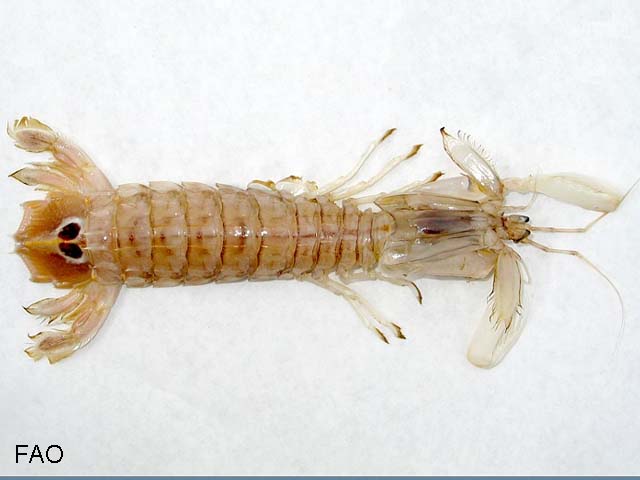| Squillidae (squillid mantis shrimps) |
| 20 cm TL (male/unsexed) |
|
benthic; marine; depth range 0 - 367 m |
| Eastern Atlantic from Gulf of Cadiz, Canary, Madeira Island and south to Angola, and the Mediterranean Sea. |
|
Stomatopod of average size; Maximum: 20 cm; common of 12 to 18 cm. Body: with very marked peaks, peaks sub median of the 5th abdominal segment with posterior spines; process lateral of the 5th thoracic segment ending in only one tooth very pointed and bent forwards. Dorsal face of the telson: with a median peak marked well and many small depressions, but deprived of lines of tubers. Dactyl of the leg: kidnapper armed with 6 spines, its regularly convex external edge. Coloring: yellowish or brownish; often reddish or bluish peaks. A dark line extends along the posterior edge from the thoracic segments, 6 to 8 and the abdominal segments, 1 to 5; a median rectangular spot sinks on the second abdominal segment; telson marked of yellow and with 2 spots dark chestnut surrounded of a white ring (Ref. 363). |
| Importance: Semi-industrial, artisanal and sporting fishing with basic trawls, trémails, bow nets, dredgers and seines of beach. Maximum depth from Ref. 106945. Benthic, strongly related to bottom sediments (Ref. 106945). Demersal above muddy bottoms (Ref. 363). Found from littoral to sublittoral depths on sandy, muddy, silty sand and sandy mud bottoms. Strongly sedentary. Burrows especially in areas with suitable burrowing substrates like fine sand and sandy mud exist. Highly territorial (Ref. 106945). |
|
Not Evaluated (N.E.) Ref. 123251)
|
|
|
Source and more info: www.sealifebase.org. For personal, classroom, and other internal use only. Not for publication.

